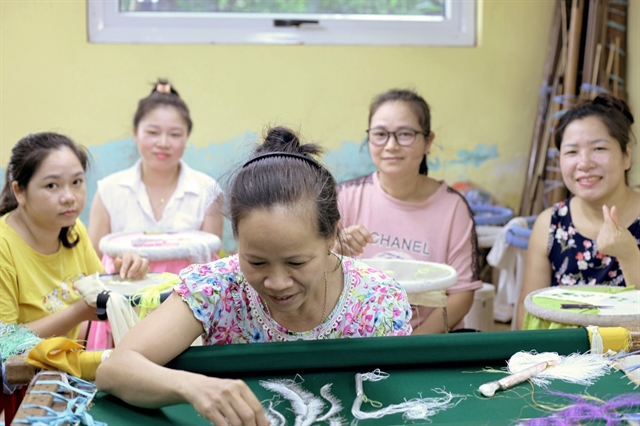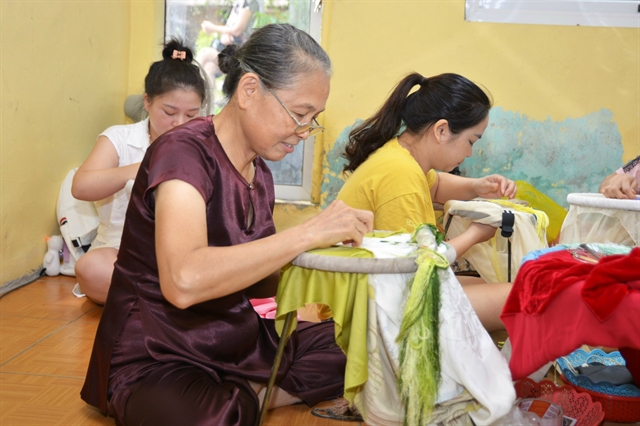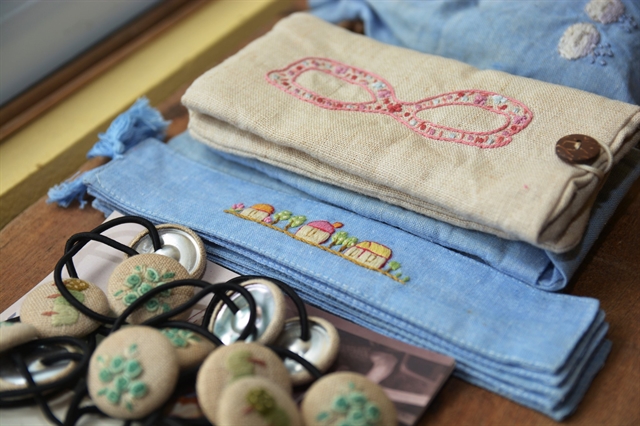Weather:
- Ha Noi 23oC
- Da Nang 28oC
- Ho Chi Minh 32oC
By Hà Linh
Hà Nội's southern outlying district of Thường Tín boasts a rich heritage of embroidery villages, among them Quất Động. The village has passed down the ancient craft through generations. However, as time goes by, the future of this cherished tradition is under threat.
As artisans find themselves grappling with whether to persist with their craft or to seek alternative employment, uncertainties await this 300-year-old art.

The centuries-old craft
Historical documents trace the roots of Quất Động’s embroidery back to Lê Công Hành born in 1606 in Quất Động. He is a mandarin under Emperor Lê Chân Tông’s reign. In 1646, he was sent as an envoy to the Ming court in China.
During the overseas mission, Hành learned the art of parasol embroidery, which he later shared with his fellow villagers when he was back home. A temple was built in his honour as the founder of the craft of embroidery in Quất Động.
“It was like everyone in the village knew how to embroider. Every household had at least an embroidery frame,” said Tạ Thị Loan, a 68-year-old embroideress.
“To my family, embroidery was everything. It was an important part of our lives, and something we took immense pride in.”
Embroidery, while a seemingly straightforward process, is actually a meticulous art requiring great skill and sharp eyes.
The working process begins with the selection of items to embroider and the drafting of their outlines on fabric. These outlines will be the foundation of the final artwork. Next, embroiderers stretch the fabric onto a frame, using small hoops for small patterns and larger frames for larger patterns or pictures. Suitable threads will then be chosen based on the materials and colours needed for the artwork. Once preparations are complete, the workers begin with the stitching.
The commonly chosen items for embroidery are symbolic trees, flowers, animals or countryside scenes. Among them are lotus, bamboo, banyan trees, pagodas, tigers, cranes, and peacocks. Each embroidered pattern requires different skill levels.
“Those at beginner level normally start with simple patterns such as grass or clouds, then move on to flowers. Only those with the high skills will be entrusted with embroidering animals and scenic spots,” Loan said.
“It requires not only embroidery skills, but also the imaginative talents of needleworkers to bring these embroidered animals to life through their stitches.”
.png)
Brink of extinction
For the people of Quất Động, embroidery represents far more than a means of making a living. It is a source of pride, a link to their heritage, and the pursuit of artistic excellence. However, the ancient craft is now on the brink of extinction.
Once, embroidery generated the primary source of income for most families in the village, but the dissolution of embroidery cooperatives in the 1980s marked a turning point. Lacking government support, needleworkers struggled to make a decent living from their craft, prompting many to turn to farming.
A glimmer of hope emerged in the early 2000s when private businesses saw the potential of the craft. They hired artisans from Quất Động to produce embroidered products for export to some Asian and European countries. However, the wages these businesses offered fell short of restoring embroidery craft to its former glory.
“Moreover they also prioritised quantity over quality to meet foreign orders, and we workers got caught up in the rush, compromising our skills,” Loan said.

"My husband was a skilled embroiderer, even better than me. But he could not earn enough from the declining craft, so he quit to get some office work,” Lê Thị Hằng said.
As the older workers turned away from the craft, fewer young people wanted to continue it.
Among Loan’s four children, none had the skills, or the will, needed to pursue embroidery seriously.
Rising from ashes
Bùi Mai Lan, a daughter of an elderly artisan, once witnessed her father chopping her family's embroidery frames for firewood because he felt hopeless about the sharp fall of the craft.
Lan finished college and worked as a journalist. She had achieved what many of her fellow villagers, including her parents, wanted – a job in a government office that offered a stable income and the guarantee of a decent pension.
However, deep down, the love for embroidery still ran through her veins. Growing up watching adults sewing, embroidery had always been a part of her life, even though she had not actively engaged in it. Her father’s act of burning the frames lit up the love inside her, motivating her to save the craft.
Lan began taking orders from colleagues and sent them to embroiderers in her native village Quất Động. Eventually, she resigned from her journalist job to fully dedicate herself to her new startup – Tú Thị Hand Embroidery.

The shop mainly makes embroidered áo dài, with the decorative patterns on the women's traditional long dress designed by themselves. They also make smaller embroidery items like handkerchiefs, pouches or scrunchies.
All the products are made at Lan’s ancestral home in Quất Động. Currently, the shop employs around 10 workers, all of whom are local residents.
Tú Thị shop designs and embroiders the products based on the customers’ requests.
“We understand that each embroidery pattern conveys a unique message, and we always try to make sure that these messages are delivered through each and every stitch,” said embroideress Nhàn.
“Some products may need a few days to complete, while others take several months, or even up to a year, depending on the complexity of the artwork."
“There are simply no two hand-embroidered products that are exactly alike. That’s what makes them truly special,” said embroideress Hằng.
People’s appreciation for these intricately embroidered products is evident through Tú Thị’s popularity, with more than 10,000 likes on their Facebook page alone.

“New orders keep pouring in, especially around the Tết (Lunar New Year) holiday. They are enough to keep us busy all day, every day,” Hằng said.
The influx of new orders brings joy to everyone at Tú Thị, not just because it provides them with a stable income, but also because it signifies the revival of the village’s centuries-old tradition.
“For me, embroidery is like breathing. It’s something natural to me, something I can’t live without. I left embroidery briefly before, only to return to it after two or three years. It just fills me with happiness to see people bustling around the embroidery frames again,” said Loan, a 68-year-old embroideress.
"This way, I hope our tradition can thrive for many generations to come.” VNS


